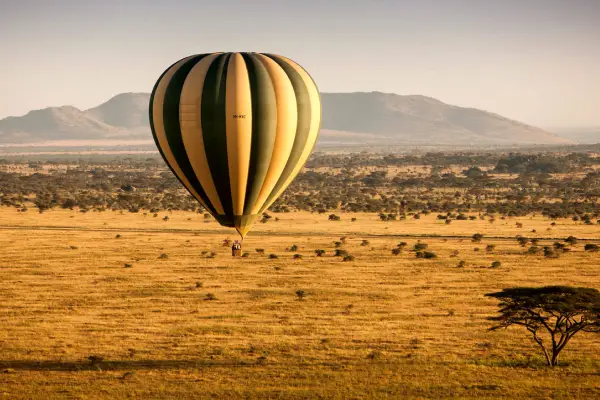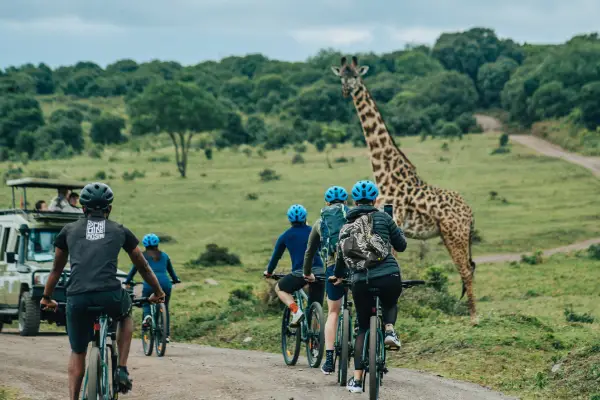100% refundable deposits
100% refundable deposits
Ever wondered what people eat in Tanzania? Tanzania Food is full of tropical flavours and East African staples. Some think East African food is bland, but that's not true! Tanzania has rich soil and a great climate for growing fresh, tasty ingredients all year round.
The food here mixes local produce with Persian, Indian, and Portuguese styles. On your Tanzania Safari Tours, you will find many restaurants offering Italian, Chinese, and more. Enjoy the delicious and varied Tanzania Foods during your trip!
Tanzania's food has been shaped by its history of trade with the Arab world and India. You can see this in dishes that use Indian spices and Persian rice. Traditional Tanzania Foods use local ingredients like bananas and coconuts.
There are over 100 tribes in Tanzania, each with its food. Tribes near Lake Victoria and Lake Tanganyika use a lot of fresh fish, while tribes in the highlands or farming areas use meat and corn. Exploring Tanzania's Traditional Food on your Tanzania Safari Tours is a tasty and fun experience.
If you’re visiting Tanzania and don’t know where to start, here are some must-try Tanzania Staple Foods:
This is the main food in Tanzania. Ugali is a thick cornmeal porridge, like polenta. It's served with meat or vegetable sauce and fills you up fast. It’s called 'posho' in East Africa and is similar to 'fu-fu' in West Africa.
These are flatbreads similar to Indian chapatis. They have soft and crispy layers. You can eat them for breakfast or with Tanzanian stews. Fresh chapatis are great anytime!
This is a salad made with tomatoes, cucumbers, and red onions. It's like a Greek salad without the cheese. The vegetables are fresh and sometimes cut very thin to show the cook’s knife skills.
These tasty dishes will give you a real flavour of traditional food and make your Safari Tours Tanzania more enjoyable.
Tanzania has some tasty breakfast treats you should try during your visit. Here are a few popular ones:
These are local doughnuts shaped like triangles or rectangles. They aren’t covered in sugar or chocolate like the doughnuts you know. They taste great with sweet tea.
These are like fried rice cakes. Cooked over open flames, each ‘kitumbua’ has a crispy outside and a warm, gooey centre-like rice pudding.
These are crunchy fried cakes. They are best when fresh and hot. These dense dough pieces fill you up fast, so start with one or two.
Enjoy these delicious foods for your breakfast during your Tanzania Safari Tours!
Tanzania has lots of vegetarian and vegan-friendly food options that are both healthy and filling. Here are some favourites you can enjoy on your Safaris in Tanzania:
This means "greens" in Swahili, like spinach, kale, and collards. These greens are often served as a side dish. You can eat them with ugali for a simple meal or add them to other main dishes.
This popular dish is made with beans cooked in coconut milk, making a creamy vegan sauce. The type of beans can include red, kidney, or black-eyed peas, depending on the region. You can also swap the rice for chapati, a crispy flatbread, to eat with your beans.
This isn't just any fruit salad. In Tanzania, it might include not only papaya, banana, and pineapple but also carrots and cucumbers for extra crunch and sweetness.
This traditional stew combines beans and corn, making a dish similar to bean chilli. It's especially good during the maize harvest when the corn is fresh and sweet.
These dishes show the variety of vegetarian foods in Tanzania, making sure you have delicious and nutritious meal options while travelling.
Here’s a list of tasty meat dishes you should try when visiting Tanzania. These dishes are perfect for trying different flavours and enjoying your meals during your Tanzania Safaris:
|
Dish Name |
What It Is |
What Comes with It |
|
Nyama Choma |
Tanzania's traditional barbecued meat, usually goat or beef, marinated with onions, garlic, and lime. |
Fries and hot sauce |
|
Pilau |
Spiced rice with meat, flavored with cardamom and cinnamon. |
Eaten on its own |
|
Fish in Coconut Sauce |
Fish cooked in a creamy coconut sauce, changes based on where you are in Tanzania. |
Served with white rice |
|
Ndizi Nyama |
Stew made with green bananas and meat or fish, from the Chagga tribe near Mount Kilimanjaro. |
Enhanced with coconut milk |
|
Chicken and Chips |
Grilled chicken served with fries and salad, a quick and popular meal. |
Comes with cabbage salad |
|
Chips Mayai |
Fried omelette made with eggs and fries, a favorite street food snack. |
Usually enjoyed with ketchup |
Experience the rich flavors of Tanzania Foods on your next Tanzania Safari Tours. Try everything from hearty breakfasts to spicy meals and sweet treats. Each bite tells a story of Tanzania's culture and history.
Get in touch with us to plan your tasty journey through Tanzania! Explore different meals and make your trip deliciously memorable.

All itinerary activities with a local, certified guide

We provide Kailas X3 III alpine tents with vestibules

All nutritious meals while on the trek.

To and from the airport and everything in between

All permit fees and taxes

Solo-friendly by nature, join our small groups



 25°C
25°C
 45MM
45MM
January is a lush and vibrant time in the Serengeti, marking the peak of the calving season. The southern plains come alive with newborn wildebeests and zebras, offering a spectacular wildlife experience. The weather is warm with occasional showers, creating a green and flourishing landscape. This period is ideal for observing young animals and their interactions with predators, all while enjoying a relatively quiet park with fewer tourists.
 25°C
25°C
 45MM
45MM
February continues the calving season with a high concentration of newborns across the southern Serengeti. The lush vegetation supports large herds of wildebeest and zebra, and predator activity remains high, making it an exciting time for wildlife viewing. The weather remains warm with occasional rains, and the park is still less crowded, providing excellent opportunities for intimate wildlife experiences.
 25°C
25°C
 45MM
45MM
By March, the calving season begins to wind down, and the herds start moving northward. The landscape remains green and vibrant due to ongoing rains, but the vegetation starts to thicken, which can make wildlife spotting more challenging. However, the park’s reduced number of visitors means a more serene safari experience, and the start of the migration northward offers exciting prospects for observing the moving herds.
 25°C
25°C
 45MM
45MM
April is characterized by heavy rains, making it one of the wettest months in the Serengeti. The landscape transforms into a lush paradise, but the roads can become muddy and challenging to navigate. Wildlife viewing can be more difficult due to dense vegetation and wet conditions, but the park’s reduced tourist numbers offer a quieter experience and a unique opportunity to see the park in its most verdant state.
 25°C
25°C
 45MM
45MM
May continues with the long rains, maintaining the park’s lush, green appearance. The increased vegetation can obscure wildlife, making sightings more difficult. However, this is a less crowded time, providing a peaceful safari experience. As the migration herds start moving north, there are opportunities to witness the beginnings of the migration, offering a quieter but still engaging wildlife experience.
 25°C
25°C
 45MM
45MM
June marks the beginning of the Avg Temperature, with warm, pleasant weather and minimal rainfall. The landscape starts to dry out, and wildlife concentrations increase around water sources, making it easier to spot animals. The Great Migration typically begins its journey northward, and the park’s clearer conditions provide excellent opportunities for viewing river crossings and large gatherings of wildlife.
 25°C
25°C
 45MM
45MM
July is one of the prime months to visit the Serengeti, as the Avg Temperature is in full swing. The Great Migration reaches the northern Serengeti, where dramatic river crossings occur. The dry conditions ensure clear visibility and easier access to wildlife, though it is also the height of the tourist season. The warm weather and high concentrations of wildlife make for an unforgettable safari experience.
 25°C
25°C
 45MM
45MM
August continues with excellent conditions for wildlife viewing as the Great Migration remains in the northern Serengeti. The dry, warm weather makes for clear skies and easy access to the park’s various wildlife hotspots. This is an ideal time for witnessing the spectacular river crossings and observing large predator populations, though it can be quite busy with tourists.
 25°C
25°C
 45MM
45MM
In September, the Avg Temperature persists, providing excellent conditions for game viewing. The Great Migration herds are still moving south, and wildlife remains concentrated around water sources. The dry weather and open landscapes make it easier to spot animals, and the crowds start to thin out slightly, offering a more relaxed safari experience compared to peak months.
 25°C
25°C
 45MM
45MM
October marks the transition from the Avg Temperature to the short rains. The Great Migration herds continue their southward movement, and wildlife is concentrated around remaining waterholes. The landscape begins to show signs of green as the rains approach, and the park sees fewer tourists, making for a more tranquil and enjoyable safari experience.
 25°C
25°C
 45MM
45MM
November brings the start of the short rains, with occasional showers and a rapidly greening landscape. The migration herds continue moving south, and the park’s transformation into a lush environment offers beautiful scenery. The reduced number of visitors and vibrant landscape provide a serene and picturesque safari experience.
 25°C
25°C
 45MM
45MM
December features ongoing short rains, which further enhance the park’s lush and green appearance. The calving season begins in the southern Serengeti, with herds returning and newborn animals becoming more common. The warm weather and vibrant environment, combined with fewer tourists, create an ideal setting for observing new life and enjoying a peaceful safari.

Talk to Us. Our Experts are just a Click Away!












I hiked Killimanjaro with a local company called Ascend Tanzania. I could not recommend a company more highly.






I had no idea what I was signing up for when I decided, without any prior experience of a trek of this calibre






Climbing Kilimanjaro was one of my greatest mountain experience so far.






Ascend is a top-notch Kilimanjaro tour guide company that I would highly recommend






Ascend tanzania is an affordable company run by the most efficient local people!
"Excellent Company To Climb With"
I booked my Kilimanjaro climb (6 Day Machame route) with Ascend Tanzania because I was travelling solo and on a budget
Read Reviews